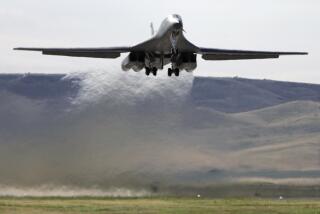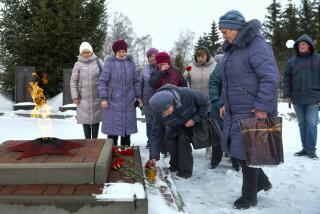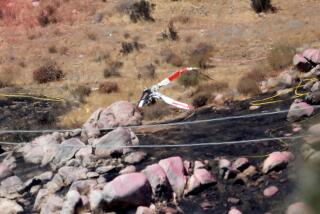Reports Fault U.S. Pilots in Deaths of Canadian Soldiers
WASHINGTON — U.S. and Canadian investigations into a “friendly fire” bombing in Afghanistan that killed four Canadian soldiers in April both found that two F-16 pilots violated procedures and one overrode an order to hold his fire, officials said Friday.
A summary of the Canadian report, released Friday, said that muzzle flashes from an approved training mission by the soldiers were so far below the U.S. pilots that they posed “no threat” to the planes, which had been ordered not to fire.
A classified 1,500-page report by the United States, which was described but not released Friday, concluded that the pilots exercised “inappropriate use of lethal force,” said Marine Lt. Gen. Michael DeLong, deputy commander of the U.S. Central Command in Tampa, Fla.
The bombing was the deadliest incident involving Canadian troops in a combat zone since the Korean War and strained U.S. relations with one of its closest allies. Some U.S. officials believe that it contributed to the Canadian Defense Ministry’s announcement that it would pull its soldiers out of Afghanistan next month, a decision officially attributed to Canadian forces being stretched too thin.
The reports found that the two F-16 pilots were flying over Tarnak Farms, a former Al Qaeda training site south of the city of Kandahar that the U.S. military turned into an approved live-fire training ground, about 2 a.m. on April 18 when the lead pilot saw what he described as fireworks.
The pilot, who was returning to Al Jaber Air Base in Kuwait after a long patrol over Afghanistan, was given permission from a nearby Air Warning and Control System, or AWACS, surveillance plane to target the flash site, but not to fire. As he “locked on,” the second pilot--his wingman--saw more flashes that he thought were surface-to-air missiles and asked for permission to fire his 20-millimeter cannon. The AWACS commander told him to hold fire and asked for more information.
The wingman gave the information but then immediately said he was responding to the perceived threat “in self-defense,” as fighter pilots are allowed to do, a summary of the U.S. report said.
The pilot plunged to 10,000 feet and dropped a 500-pound laser-guided bomb that killed the four Canadians and injured eight.
The Canadian soldiers, from the 3rd Battalion of the Princess Patricia’s Light Infantry Brigade, were firing a range of weapons, from pistols to shoulder-fired antitank guns, but not surface-to-air weapons, defense officials said.
The Canadians took all necessary precautions, according to the reports. They had sought approval for the night-firing training at a designated training site routinely used by coalition soldiers and even stationed a Canadian sentry in the air control tower at the U.S. base in Kandahar, the Canadian report said. Both reports cleared the Canadians of any blame.
The next step could be disciplinary action. The Canadian report recommends that both pilots face a hearing to decide whether criminal charges should be filed. The U.S. document recommends a range of potential disciplinary actions, though defense officials declined to say what they were.
Gen. Tommy Franks, who as commander of the U.S. Central Command is directing the war, passed the U.S. report on to Air Force officials to consider any actions against the pilots.
Canada has no say in punishing the pilots.
“There is nothing we can do to bring our lost soldiers back, but we will do all that is humanly possible to mitigate the risk of such a tragedy happening again,” said John McCallum, Canada’s defense minister.
Military officials declined to name the pilots, but they have been identified in news reports as wingman Maj. Harry Schmidt and lead pilot Maj. William Umbach, both of the Illinois Air National Guard’s 170th Fighter Squadron. The incident is particularly embarrassing to the Pentagon because Schmidt is a former instructor at the Navy’s elite Top Gun fighter school.
Schmidt’s attorney, Capt. James Key, has complained that a “gag order” has prevented him from talking to about 70 witnesses who have been interviewed in the investigations.
Pentagon officials left open the possibility that other officers might be punished. U.S. investigators found that “failings within the pilots’ immediate command structures, while not causing the incidents, were contributing factors,” DeLong said.
More to Read
Sign up for Essential California
The most important California stories and recommendations in your inbox every morning.
You may occasionally receive promotional content from the Los Angeles Times.










